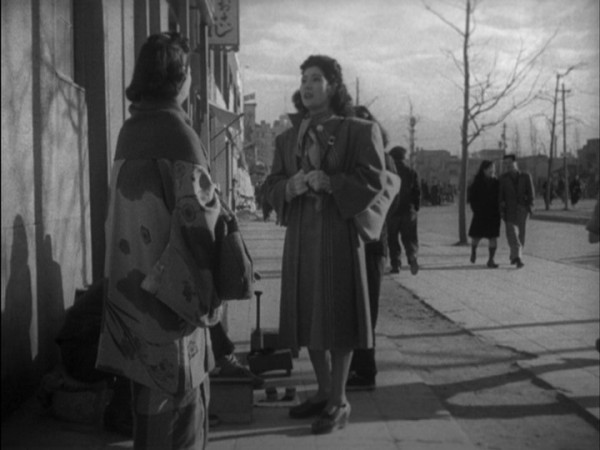WOMEN OF THE NIGHT (YORU NO ONNATACHI) (Kenji Mizoguchi, 1948)
Museum of the Moving Image
35th Ave. at 36th St., Astoria
Sunday, June 8, 4:30, free with museum admission of $12
Series runs May 2 – June 8
718-777-6800
www.movingimage.us
 “I’ll find freedom and happiness my own way,” Kumiko (Tomie Tsunoda) declares in Women of the Night, but there’s no freedom or happiness for women in Kenji Mizoguchi’s bleak vision of postwar Japan. Based on the novel Joseimatsuri by Eijiro Hisaita, the 1948 film is another in the director’s series of harrowing works dealing with women who are given no option in society other than prostitution. Fusako (Kinuyo Tanaka) is trying to make ends meet as she awaits her husband’s return from the war and nursing her sick infant, but after learning that her husband is dead and losing their child to tuberculosis, she has little choice but to start selling her body. When her younger sister, Natsuko (Sanae Takasugi), finds out what she is doing, she tries to save her, but the system is against them. Meanwhile, Fusako’s young sister-in-law, Kumiko, decides to run away, but she is quickly beaten down as well. Mizoguchi, whose family sold his sister into prostitution, explored similar territory in such earlier films as Sisters of the Gion and Osaka Elegy and in his 1956 masterpiece, Street of Shame, sets Women of the Night in a near-postapocalyptic landscape, the ruined women equated with the rubble surrounding them, lending the film a neo-Realist quality. Nearly all of the men in the film are bad, creating conditions that have the women fighting against one another instead of helping each other out of their ever-more-dire circumstances. It’s a dark, unrelenting film featuring several daring shots, leading to a brutal, memorable finale. Women of the Night is screening June 8 at 4:30 as part of the Museum of the Moving Image’s five-week tribute to the master auteur — who made more than eighty films, less than half of which still exist — and continues with such other works as Princess Yang Kwei-fei, The Lady of Musashino, A Woman of Rumor, and Tales of the Taira Clan.
“I’ll find freedom and happiness my own way,” Kumiko (Tomie Tsunoda) declares in Women of the Night, but there’s no freedom or happiness for women in Kenji Mizoguchi’s bleak vision of postwar Japan. Based on the novel Joseimatsuri by Eijiro Hisaita, the 1948 film is another in the director’s series of harrowing works dealing with women who are given no option in society other than prostitution. Fusako (Kinuyo Tanaka) is trying to make ends meet as she awaits her husband’s return from the war and nursing her sick infant, but after learning that her husband is dead and losing their child to tuberculosis, she has little choice but to start selling her body. When her younger sister, Natsuko (Sanae Takasugi), finds out what she is doing, she tries to save her, but the system is against them. Meanwhile, Fusako’s young sister-in-law, Kumiko, decides to run away, but she is quickly beaten down as well. Mizoguchi, whose family sold his sister into prostitution, explored similar territory in such earlier films as Sisters of the Gion and Osaka Elegy and in his 1956 masterpiece, Street of Shame, sets Women of the Night in a near-postapocalyptic landscape, the ruined women equated with the rubble surrounding them, lending the film a neo-Realist quality. Nearly all of the men in the film are bad, creating conditions that have the women fighting against one another instead of helping each other out of their ever-more-dire circumstances. It’s a dark, unrelenting film featuring several daring shots, leading to a brutal, memorable finale. Women of the Night is screening June 8 at 4:30 as part of the Museum of the Moving Image’s five-week tribute to the master auteur — who made more than eighty films, less than half of which still exist — and continues with such other works as Princess Yang Kwei-fei, The Lady of Musashino, A Woman of Rumor, and Tales of the Taira Clan.
